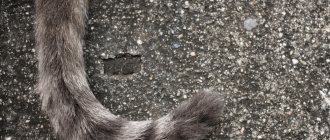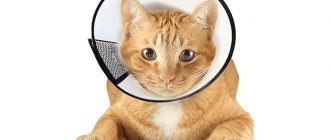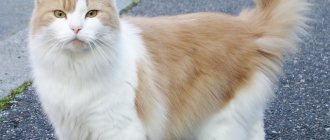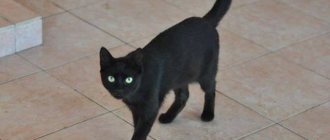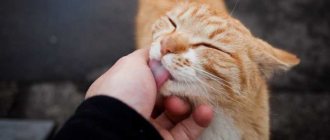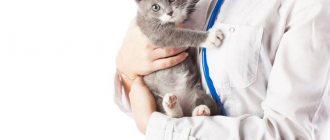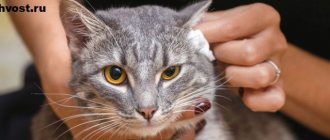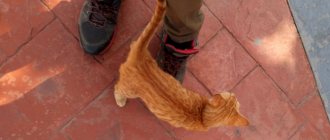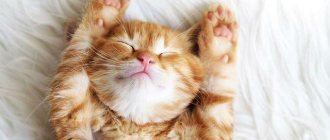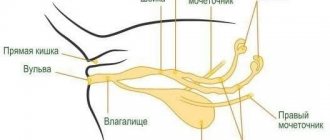By watching a cat wag its tail, you can determine what emotions it is experiencing. After all, animals need it not only for balance in jumping, but is an indicator of mood. A nervous tail wagging indicates anger, a lowered tail indicates fatigue, and a raised tail indicates a playful mood. There is an alphabet of positions and movements of a pet's tail, which helps determine the pet's mood.
Structure of a cat's tail
The tail is the most interesting part of the spine, containing the most vertebrae. The tails can have from a dozen to 28 vertebrae.
In some breeds of short-tailed cats, you can find very interesting tails, in which the number of vertebrae is minimal, or they are completely fused. Also, in such cats, the tail vertebrae may be shorter. For example, the Kurilian and Japanese bobtail tails can have from a couple to a dozen vertebrae of reduced length.
A breed of cats without a tail is the Manx and the Cymric cat. They do not have tails at all (they have 3 caudal vertebrae, but the tail is not visible). These two breeds can be genetically burdened with back defects, so tailless cats should be crossed with animals that have a tail; it is strictly not recommended to cross two individuals without a tail. Japanese and Kurilian bobtails are not genetically burdened with diseases.
Between the legs
When a cat hides its tail between its paws, it demonstrates its submission. Sometimes this happens in moments of sadness or frustration, if the pet wants to be alone. Sometimes the cat is afraid of something, so he tucks his tail.
Compared to the previous tail gesture, tucking, on the contrary, visually makes the individual smaller - as if the cat wants to hide and become invisible to anyone.
Fluffies also love to cuddle with their tails. This is a very friendly and loving gesture, so it should not be ignored.
Why do cats need tails?
Let's figure out what a cat's tail is for?
Equilibrium
Why do cats need a tail? Its main function is to help the cat maintain balance, for example when balancing on a narrow wall or when falling, so that the cat can roll over straight onto its feet. Of course, the tail is not the main organ that determines a cat’s ideal sense of balance. And sometimes, when it comes to climbing or walking on a fence, tailless or short-tailed cats don't stand out too much from other cats.
However, the tail makes it much easier to maintain balance. It is somewhat reminiscent of a tightrope walker's pole, allowing the body to be balanced by acting as a counterweight. Its soft but precise movements prevent you from losing your balance and falling. Thanks to this, the cat can easily walk even on very narrow surfaces. Appropriate movements of the tail allow the animal to turn its body during the fall and guide it so that the cat lands directly on its paws.
Hunting
The tail of a cat plays a very important role during hunting, and in cats that spend a lot of time in trees, it also serves for movement. Cats such as the margay or clouded leopard can move very deftly along tree branches, hunting various animals and birds.
On the other hand, cats that hunt in open areas use their tail to make sharp turns while running. And the clearest example of this is the cheetah, which does not need to slow down to enter a sharp turn while chasing an evasive gazelle. The domestic cat also uses its tail to run and climb trees. Although it must be admitted that in this she is far from her wild relatives, against whom she looks rather clumsy.
Touch
This is another interesting role of the tail. The cat's tail plays a supporting role in the sense of touch. Although it is not as sensitive as the whiskers, there are also many nerve endings on its surface. The tail helps the cat explore its environment using tactile cues. It is easy to notice that most cats do not like having their tail touched or stroked - for them it is an irritant.
Possible problems with the tail
The shape is the first thing that catches your eye when examining a cat's tail. Its deformed vertebrae can protrude beyond each other, forming a “ladder.” When kinked, they fold down, and when creased, they fold upward. With these types of deformities, all vertebrae have different sizes and may have rounded edges. Curvatures in which one of several vertebrae forms an angle, deviating from a straight line, are called bends.
These types of tail deformities may not cause pain to the animal, but will certainly end a show career.
Serious problems that affect the general condition of the cat include:
- Fractures. The bone marrow ends in the lumbar spine, but the nerve endings are located along the entire length of the cat's tail. Therefore, when this part of the body is injured, the animal experiences acute pain. Tail fractures in cats are diagnosed using x-rays and are accompanied by swelling.
- Education and cones. Any tumors on a cat's tail require diagnosis. If a malignant neoplasm is detected, part of the pet’s tail may be amputated to prevent the occurrence of metastases.
- Dermatological problems. The presence of skin diseases is indicated by the appearance of dandruff, sebaceous hairs, severe itching, and the formation of ulceration wounds. And some dermatological pathologies are accompanied by partial or complete baldness.
A cat's tail is a multifunctional organ that helps maintain balance, express emotions and regulate body temperature. And although the animal can adapt to living without it, it gives her clear advantages.
What does a cat's tail mean in behavior?
A cat's tail also serves a communicative function. The position of the tail and its movements are among the elements of body language. A cat uses its tail to convey its mood and emotional state: from satisfaction to fear and irritation.
However, a cat’s messages are best read not only from the tail, but also taking into account all the combined verbal and non-verbal signals.
Why does a cat raise its tail?
Friendliness
A raised tail with a slightly curved tip is one of the most characteristic messages, probably known to every owner. This is a communication element used primarily by kittens to greet their mother when she enters the house. Then gradually the cats began to communicate in this way with people.
A raised tail indicates a friendly attitude and expression of good intentions towards a person. This signal was originally used only by kittens, but probably early in domestication, cats began to use it as a "flag" to signal friendliness first to another cat and then to humans.
Wild cats still use this signal only to communicate between their cubs and their mother.
Communication with kittens
An additional function of the tail in wild cats is to signal kittens to follow their mother. For example, a leopard's tail has a characteristic white stripe. The female lifts it high and carefully moves it to attract the attention of her babies and guide them along the desired route through the tall grass, above which only the tail is clearly visible.
Definition of territory
A cat can also raise its tail for a completely different purpose - to mark the area with urine. The cat shakes its tail, raised vertically, and then releases a stream of urine onto the selected vertical surface. Most often, uncastrated males and females do this. The longer an owner delays castration of a cat, the greater the risk that the animal will continue to mark its territory even after castration.
If the tail is half or completely down
this is a sign of calm; at the same time, the cat’s whole body becomes free, relaxed, the whiskers do not show activity and are freely located along the cheeks, the ears are straightened, but in an anatomical position;
If the tail is slightly raised, with a slightly curved tip
it expresses curiosity, interest;
If the tail is wrapped around the paws of a cat in a sitting position
this can be a sign of both calmness, a relaxed and friendly attitude (the muzzle is relaxed, the eyes are open or narrowed, and the body is free) and tension (the cat is exploring an animal or person). At such moments, the cat is on alert.
Sometimes a cat wraps its tail around its paws because it is simply cold.
If the tail is curled under the belly
This is a sign of fear in a cat.
If the tail is raised and arched
and if the fur is still raised, this is a sign of defensive aggression; The cat may attack if pinned against a wall, but will try to scare off the opponent or run away if possible.
Raising the tail, as well as the hair on the back, is an attempt to scare off the enemy, creating the impression that it is larger and more dangerous than it actually is. This position may be accompanied by moaning, hissing and snorting.
If the tail is curled
A cat ready to attack may also curl its tail and tuck it between its legs - the same signals are transmitted through the ears and mouth.
If the tail is curled
a curved tail in the shape of an inverted "U" - usually means a desire to play; This tail position is observed in kittens, but adults often do this when they are ready to play.
From side to side
This gesture can mean several emotions at once. It is important to take a close look at your pet to understand exactly what he is feeling right now:
- intense interest - if the cat is focused on something, waiting or hiding in anticipation of prey (most often, a toy);
- pleasure - for example, if the pet is currently licking and grooming itself;
- anger - if the tail knocks loudly on the floor;
- an invitation to play - to a person or another pet.
What functions does it perform?
Whether the tail is long, short, fluffy or hairless, whatever it is, it has an important role in the life of the animal. It is worth noting that it is a continuation of the spine, where many nerve endings are concentrated. The excretory process and the movement of the hind legs depend on it. But this is not the entire list of functions performed; it has much more purposes.
Maintaining balance
Cats have an exceptionally developed sense of balance. And to maintain balance in the most incredible situations, the tail serves as a rudder. This is why cats easily climb trees and walk along thin branches. In addition, it acts as a parachute and helps to achieve a good body position for a soft landing when jumping. The tail makes a real hunter out of a cat.
Comfort and entertainment
To keep warm, your pet can cover the tip of its nose with this fluffy appendage.
Cat tails create the necessary microclimate for animals. When it's hot, they use it as a fan and cool themselves this way. And when it’s cold, they lie down and wrap themselves with their tail, sometimes even covering their nose. This is how they retain their body heat. In addition, they entertain and keep you from getting bored. Small kittens especially often play with their mobile part of the body.
Location orientation
To maintain this important function for the animal, the whiskers and tail complement each other. They give the cat the skill of orientation when moving in complete darkness. Coarse hair on the sides of the upper lip helps you feel around and avoid obstacles, rather than losing your balance. In another way, they can be called a built-in navigator in the cat’s body.
What does a cat's raised butt mean while stroking?
When a cat lifts its hindquarters while being stroked, it shows that it completely trusts the person. The cat considers him his friend and is not afraid at all.
Stroking a cat can be accompanied not only by raising the back of the body. The cat can fall on its back, exposing its tummy, turn in different directions and purr. This indicates that the cat likes it, is calm and feels safe.
Various body movements for animals are options for communicating with humans. As kittens, they learn to communicate with their mother. Then, having become someone’s pet, the cat begins to treat its owner like its mother. If an animal bites the owner's hand a little while playing, there is no need to be offended by him, because this is simple playfulness.
The cat's raised butt is a memory from childhood, when he greeted his mother with such a gesture. That is, the cat considers its owner to be a big mother who must feed him, comb him and take care of him.
Movement of the cat's whiskers and ears
Every cat has ears that stick out all the time, with the exception of the British Shorthair, they either spread out to the sides or rotate to catch sound. Even when she is just lying down, her eyes are closed, not moving, only her ears are moving - this means that she is not sleeping and hears everything. When she presses her ears back, she wants to play, when they are pressed to the sides, it means there is no time for games, she gets angry. She lay down on the ground, closed her eyes a little, pressed her ears to her head - this is a sign of submission. The movements of the mustache repeat the state of the mood - either twitch or change its position. It also happens that cats’ whiskers fall out, and why would that be?
What can our eyes tell us? If they are wide open, she is wondering what you are doing there, half-closed is a sign of bliss and pleasure, stroke her and you will understand. Sometimes they can look at one point, as if there is something there... In general, do you know how cats see the world? A very unusual vision!
And the cat who sits near the door and looks up. Everyone knows that she wants, of course, to go out. If she sits near the door and lowers her eyes, it means there is someone behind the door.
How to understand cat gestures
Cats often greet their owners. They approach a person with their tail raised. In this case, you need to show a response, for example, by scratching the animal behind the ear. If a cat lies belly up in front of a person, it means that he completely trusts him. However, in this case, the cat is not always happy if his stomach is tickled. But you can safely stroke your head.
It is believed that if a cat rubs against a person's legs, he is asking for food. However, such actions can also occur if the cat thinks that the owner smells strange. So the cat will try to correct the scent by leaving its scent on the person.
A cat can lick its lips not only after eating. It happens that this indicates nausea or stress. The relaxed state of the cat is also indicated by its posture. In this case, the animal will lie down and blink its eyes slowly.
Cats and cats have a calmer and more complex behavior than dogs. It is much more difficult to understand the facial expressions of these fluffies, because their special muscles on their faces are not so developed. That is why cat owners should not focus on the animal’s facial expressions, because you can easily make a mistake.
Subject:
- Cats
History of the breed
In 1998, California resident Susan Manley took a small, weakened cat from the street and took him out. The grown-up pet, named Solomon, soon began to fold its tail into an unusual ring, which attracted the attention of the owner. After contacting veterinarians, Susan learned that this trait is a genetic trait, and similar cats can be found in different cities of California. This inspired S. Manley to study and develop a separate cat breed.
Since 1999, on the initiative of the American Susan Manley, targeted work began to consolidate the “ring-tailed” gene. In 2004, the breed received the official name “American Ringtail” and in 2005 it already received experimental status according to TICA. In the same year, breeders managed to breed a long-haired cat with a curled tail.
Now the breed of ring-tailed cats is gaining popularity in the United States of America and Canada, despite the fact that felinological associations have not yet issued certificates of official recognition of American ringtails.
What is special about this breed and why do breeders like it?
The tail is fluffy and looks like a bottle brush
The cat has a broken tail: what to do?
A fluffy tail means the cat is scared. This way she wants to appear bigger, while at the same time she can fluff up the fur all over her body. Sometimes it is difficult to predict what particular event or object may frighten a cat, but if this suddenly happens, then such a position of the tail will allow the owner to remove the irritant from sight and calm the pet.
